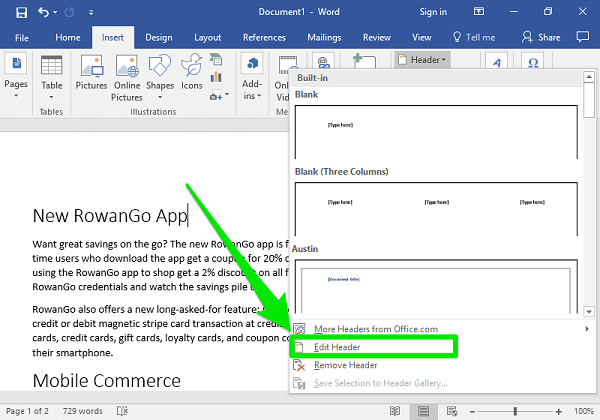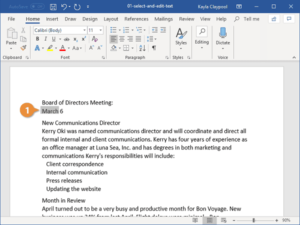Headers and Footers- Headers and footers are sections of a document that appear at the top (header) and bottom (footer) of each page, respectively. They are commonly used in word processing software like Microsoft Word, Google Docs, and others to provide consistent information or formatting across multiple pages. Here’s a brief overview of headers and footers:
Headers:
- Purpose: Headers are typically used to display information such as page numbers, document titles, chapter titles, author names, or dates at the top of each page.
- Customization: Users can customize headers to include different elements such as text, images, page numbers, date & time, etc.
- Consistency: Headers ensure consistency across all pages of a document, making it easier to navigate and understand.
- Sections: Headers can vary from section to section within a document, allowing for different information to be displayed based on the document’s structure.
Footers:
- Purpose: Footers serve a similar purpose to headers but are positioned at the bottom of each page. They commonly contain page numbers, document titles, dates, or other relevant information.
- Content: Similar to headers, footers can contain text, images, page numbers, dates, or other elements.
- Page Numbers: One of the most common elements found in footers is page numbering, which helps readers keep track of their progress through the document.
- Consistency: Like headers, footers ensure consistency across all pages of a document, providing a professional and organized appearance.
Usage Tips:
- Relevance: Ensure that the content in headers and footers is relevant to the document’s purpose and audience.
- Clarity: Keep headers and footers concise and easy to read to avoid cluttering the document.
- Formatting: Use consistent formatting (font style, size, color, etc.) for headers and footers to maintain a cohesive look.
- Differentiation: Differentiate headers and footers as needed for distinct sections or chapters within a document.
- Review: Always review headers and footers to verify accuracy and consistency before finalizing a document.
Headers and footers are valuable tools for enhancing the readability, professionalism, and organization of documents, particularly those with multiple pages or sections. By using them effectively, you can provide readers with important contextual information while maintaining a polished presentation.
What is Required Headers and Footers
“Required headers and footers” typically refer to specific elements that must be included in certain types of documents or according to specific formatting guidelines. These requirements can vary depending on the purpose of the document, organizational standards, or style guides. Here are some common examples:
Required Headers:
- Document Title: The title of the document, often displayed at the top of each page.
- Page Numbers: Sequential numbering of pages to facilitate navigation and referencing.
- Author/Creator Name: The name of the person or organization responsible for creating the document.
- Date: The date the document was created, last revised, or another relevant date.
- Section Titles: If the document has distinct sections, headers might include section titles to help readers navigate.
Required Footers:
- Page Numbers: As with headers, page numbers are often placed in footers for consistency.
- Confidentiality Notice: In sensitive documents, a confidentiality notice might be required in the footer.
- Copyright Information: For copyrighted documents, the copyright symbol, year, and owner might be placed in the footer.
- Document Version: If the document undergoes revisions, the version number or revision date might be included.
- Contact Information: Footer might include contact details for the organization or author for inquiries.
Other Considerations:
- Legal Requirements: In some cases, legal or regulatory requirements might dictate specific information that must be included in headers or footers.
- Style Guides: Organizations often have style guides or formatting standards that dictate what should be included in headers and footers for consistency across documents.
- Accessibility: Consider accessibility standards when designing headers and footers, ensuring they are readable by screen readers and compliant with accessibility guidelines.
Ultimately, required headers and footers serve to provide essential information, facilitate document navigation, and ensure consistency and compliance with relevant standards or guidelines. It’s important to review any specific requirements or guidelines applicable to your document to ensure that headers and footers meet the necessary criteria.
Who is Required Headers and Footers
“Required headers and footers” is not a person or entity but rather a concept related to document formatting. When someone refers to “required headers and footers,” they are usually talking about specific elements that need to be included at the top (header) and bottom (footer) of each page in a document, such as page numbers, document titles, author names, or other relevant information.
When is Required Headers and Footers

“Required headers and footers” typically refer to specific elements that must be included in certain types of documents or according to specific formatting guidelines. The timing of when they are needed depends on when the document is being created, edited, or formatted. Here are some scenarios where required headers and footers might come into play:
- Document Creation: When initially creating a document, especially for formal or professional purposes, you may need to include required headers and footers according to organizational standards or style guides. This ensures that the document adheres to specific formatting requirements from the outset.
- Document Editing: During the editing process, headers and footers may need to be reviewed and revised to ensure they meet any newly established requirements or changes in the document content. Editors or authors may need to adjust headers and footers to maintain consistency or comply with updated guidelines.
- Document Formatting: Prior to finalizing and distributing a document, it’s common practice to review and finalize headers and footers to ensure they include all required elements and adhere to any applicable standards. This may involve making adjustments to font styles, alignment, content, or other aspects to achieve the desired appearance.
- Document Distribution: Headers and footers are typically included in documents when they are distributed or shared with others. Whether in print or electronic format, the required headers and footers should be present to provide necessary information and maintain consistency across all pages of the document.
- Document Updates: In cases where documents are regularly updated or revised, such as policy manuals or instructional guides, headers and footers may need to be reviewed and modified to reflect any changes in content, version numbers, or other relevant information.
In summary, the inclusion of required headers and footers is necessary throughout various stages of document creation, editing, formatting, distribution, and updates to ensure adherence to standards and guidelines, as well as to provide essential information to readers.
Where is Required Headers and Footers
“Required headers and footers” are typically found at the top (header) and bottom (footer) of each page in a document. They are part of the layout of the document and appear consistently on every page. Here’s where you can find them:
Headers:
- Headers are located at the top of each page.
- In word processing software like Microsoft Word or Google Docs, you can typically view and edit headers by accessing the “Header” section of the program.
- Headers can contain various elements such as document titles, page numbers, chapter titles, or other relevant information.
Footers:
- Footers are positioned at the bottom of each page.
- Similar to headers, footers can be accessed and edited in the “Footer” section of word processing software.
- Common elements found in footers include page numbers, document titles, dates, or other pertinent information.
Both headers and footers are part of the document’s layout and formatting, and they serve to provide consistency and essential information throughout the document. Depending on the software you’re using, you can typically find options to add, edit, or remove headers and footers in the program’s menu or toolbar.
How is Required Headers and Footers
“Required headers and footers” are typically created, edited, and formatted using the tools provided by word processing software such as Microsoft Word, Google Docs, or other similar applications. Here’s how you can create and customize required headers and footers:
Creating Headers and Footers:
- Access Header/Footer Tools: Open your document in the word processing software.
- Navigate to Header/Footer Section: Look for options such as “Insert” or “View” in the menu bar. You’ll often find dedicated buttons or tabs for headers and footers. Click on these to access the header/footer section.
- Choose a Template or Design: Many word processors offer pre-designed header/footer templates or styles. You can choose from these or create your own custom design.
- Insert Content: Once in the header/footer section, you can insert text, images, page numbers, dates, or other elements as needed. Use the available tools and options to customize the appearance and layout.
- Format and Style: Adjust the font, size, color, alignment, and other formatting settings to match your document’s style or guidelines.
- Apply to All Pages: By default, headers and footers are usually applied to all pages of the document. However, you can specify different headers/footers for specific sections if needed.
Editing and Formatting:
- Edit Content: You can easily edit the content of headers and footers by clicking within them and making changes directly.
- Modify Layout: Adjust the placement and layout of elements within headers and footers by using the available formatting options.
- Update Page Numbers: If your document has multiple pages, ensure that page numbers are set up correctly and that they update automatically as pages are added or removed.
Compliance with Requirements:
- Check Guidelines: Review any requirements or guidelines provided for the document regarding what information should be included in headers and footers.
- Ensure Consistency: Make sure that headers and footers are consistent across all pages of the document, adhering to the specified formatting and content guidelines.
- Verify Accuracy: Double-check that all required elements, such as page numbers, document titles, or other information, are accurately included and formatted according to the requirements.
By following these steps and ensuring compliance with any relevant requirements or guidelines, you can effectively create, customize, and maintain required headers and footers in your documents.
Case Study on Headers and Footers
Enhancing Document Consistency with Headers and Footers
Background: ABC Consulting is a global consulting firm specializing in providing strategic solutions to businesses across various industries. They frequently produce comprehensive reports for their clients, which often span multiple pages and require a professional presentation.
Challenge: ABC Consulting’s reports lacked consistency in formatting, making them appear less professional and organized. There was no standardization in the placement of key information such as page numbers, document titles, and dates.
Solution: To address this challenge, ABC Consulting implemented a standardized approach to headers and footers across all their documents.
Implementation Steps:
- Header Design: The design team at ABC Consulting created a header template incorporating the company logo, document title, and chapter headings. They ensured that the header appeared at the top of each page, maintaining consistency throughout the document.
- Footer Setup: In the footer section, ABC Consulting included page numbers aligned to the right and the company’s contact information aligned to the left. This ensured that readers could easily navigate through the document and contact the company if needed.
- Formatting Guidelines: The company established clear formatting guidelines specifying font styles, sizes, and colors for headers and footers. This ensured a cohesive and professional look across all documents.
- Training and Implementation: ABC Consulting provided training sessions to employees on how to implement headers and footers using Microsoft Word, their primary word processing software. They emphasized the importance of adhering to the established formatting guidelines.
Results:
- Improved Professionalism: The standardized headers and footers enhanced the overall professionalism of ABC Consulting’s documents. Clients and stakeholders perceived the reports as more polished and professional, reflecting positively on the company’s brand image.
- Enhanced Readability: With consistent placement of key information such as document titles and page numbers, readers found it easier to navigate through the reports. This improved readability and comprehension, leading to better engagement with the content.
- Time Savings: By using predefined header and footer templates, employees saved time on formatting tasks. They could focus more on content creation and analysis, leading to increased productivity and efficiency.
- Positive Client Feedback: Clients appreciated the improved consistency and professionalism of ABC Consulting’s reports. The standardized headers and footers contributed to a better overall client experience, strengthening client relationships and loyalty.
Conclusion: By implementing standardized headers and footers, ABC Consulting was able to enhance the consistency, professionalism, and readability of their documents. This not only improved client satisfaction but also contributed to increased efficiency and productivity within the organization.
This case study highlights the importance of headers and footers in professional documents and demonstrates how their implementation can drive positive outcomes for businesses.
White paper on Headers and Footers
Title: Enhancing Document Organization and Professionalism: The Role of Headers and Footers
Abstract: Headers and footers are essential elements of document formatting that play a crucial role in enhancing organization and professionalism. This white paper explores the significance of headers and footers in various types of documents, including reports, academic papers, and business presentations. It discusses the key components of headers and footers, their benefits, and best practices for their implementation. Additionally, the paper examines the impact of headers and footers on document consistency, readability, and brand perception. By understanding the importance of headers and footers and implementing them effectively, individuals and organizations can elevate the quality and professionalism of their documents.
Introduction: In today’s digital age, where information is abundant and attention spans are limited, the presentation of documents plays a critical role in conveying information effectively. Headers and footers serve as navigational aids and provide essential context and information to readers. Whether in business reports, academic papers, or presentations, headers and footers contribute to document organization, consistency, and professionalism. This white paper explores the significance of headers and footers and offers insights into best practices for their utilization.
The Importance of Headers and Footers:
- Organization and Structure: Headers and footers help organize documents by providing consistent placement of key information such as titles, page numbers, and dates. This facilitates navigation and improves document readability.
- Branding and Identity: Headers and footers can include branding elements such as logos, company names, or colors, reinforcing brand identity throughout the document.
- Professionalism and Credibility: Well-designed headers and footers contribute to the overall professionalism of a document, enhancing its credibility and perceived quality.
- Navigation and Reference: Page numbers in footers and section headings in headers allow readers to easily navigate through lengthy documents and refer back to specific sections.
- Compliance and Standards: Headers and footers can ensure compliance with formatting standards, style guides, and regulatory requirements in various industries.
Best Practices for Implementing Headers and Footers:
- Consistency: Maintain consistency in the placement, design, and content of headers and footers throughout the document.
- Relevance: Include only essential information in headers and footers that are relevant to the document’s content and purpose.
- Clarity: Ensure that headers and footers are clear, concise, and easy to read, using appropriate font styles, sizes, and colors.
- Customization: Tailor headers and footers to suit the specific needs and preferences of the document and its audience.
- Accessibility: Consider accessibility guidelines when designing headers and footers to ensure that they are readable by all users, including those with disabilities.
Conclusion: In conclusion, headers and footers are integral components of document formatting that contribute to organization, professionalism, and readability. By understanding their importance and implementing best practices for their utilization, individuals and organizations can enhance the quality and effectiveness of their documents. Whether in business, academia, or any other field, headers and footers play a vital role in conveying information clearly and effectively to readers.
This white paper serves as a guide for understanding the significance of headers and footers and offers practical insights into their implementation. By leveraging headers and footers effectively, individuals and organizations can create documents that are not only informative but also visually appealing, consistent, and professional.
Industrial Application of Headers and Footers
Headers and footers, while often associated with word processing software and document formatting, also find industrial applications beyond traditional office environments. Here are several industrial applications where headers and footers play a significant role:
- Technical Documentation: In industrial settings, technical documentation such as equipment manuals, maintenance procedures, and safety guidelines often utilize headers and footers. These headers and footers may include important information such as document titles, section headings, revision dates, and page numbers. They help organize the content, facilitate navigation, and ensure that users can quickly find relevant information.
- Quality Control Reports: In manufacturing and production facilities, quality control reports are essential for ensuring product consistency and adherence to standards. Headers and footers in these reports may contain details such as batch numbers, inspection dates, production line identifiers, and company logos. By including this information consistently across reports, headers and footers help track product history and maintain quality standards.
- Inventory Management Documents: Headers and footers are commonly used in inventory management documents such as stock lists, shipment records, and inventory tracking sheets. These headers and footers may include identifiers such as warehouse locations, SKU numbers, dates of inventory updates, and employee names or initials. Consistent use of headers and footers ensures that inventory information is organized and easily accessible to warehouse staff and management.
- Regulatory Compliance Documentation: Industries such as pharmaceuticals, chemicals, and food production must adhere to strict regulatory requirements. Headers and footers in regulatory compliance documentation often include information such as document titles, compliance codes, regulatory agency logos, and revision dates. These headers and footers help demonstrate compliance with regulations and facilitate audits and inspections.
- Process Control Documents: In industrial processes such as manufacturing, refining, and chemical processing, headers and footers are used in process control documents to track operational parameters, monitor equipment performance, and record production data. Headers and footers in these documents may contain details such as process identifiers, timestamps, operator initials, and equipment serial numbers. Consistent use of headers and footers ensures accurate documentation of process parameters and facilitates troubleshooting and analysis.
- Training Materials and Work Instructions: In industrial training programs and work instructions, headers and footers help organize training materials and provide context for learners. Headers and footers may include training module titles, section headings, course codes, and page numbers. By including consistent headers and footers in training materials, organizations can improve training effectiveness and ensure that learners can easily navigate through the content.
In summary, headers and footers have diverse industrial applications beyond traditional office settings. In industries ranging from manufacturing to regulatory compliance, headers and footers play a crucial role in organizing documentation, tracking information, ensuring compliance, and facilitating operational processes. By leveraging headers and footers effectively, industrial organizations can improve documentation management, enhance operational efficiency, and maintain compliance with regulatory requirements.





